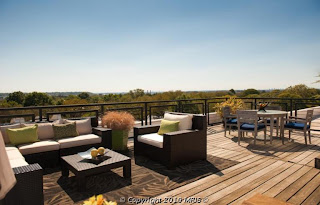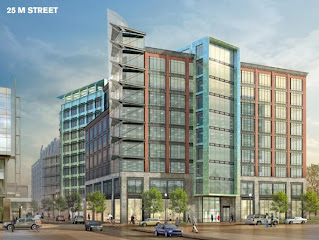National Harbor, the 300-acre multi-use waterfront, Pleasantville-wannabe development on the shores of the Potomac River in Prince George's County, Maryland, is set to receive its first apartment building in the nearish future. With an expected late-2011 groundbreaking and 2013 delivery, the recently-announced project will see 350 new apartments atop 25,000 s.f. of ground-floor retail courtesy of
Bozzuto Group. The
Peterson Companies, which originally spawned the concept of National Harbor, and has seen nearly 75% of its 400 current condominiums sold, 40% of its 46 townhomes sold, and four manor homes sold, not to mention the construction and opening of the
Gaylord National Resort & Convention Center as well as a plethora of neatly packaged retail. Peterson contacted Bozzuto over the summer about bringing the “fourth residential food group" (i.e. apartments) this to the development site. With the market steadying, and long-held dreams of building at National Harbor, Bozzuto gladly accepted the offer.
National Harbor, which will eventually feature 10 million s.f. of development programming if Peterson's ambitious plans are left unhampered by any future market meltdowns, already contains a whopping six hotels, two marinas, three condo buildings, and a slowly growing number of shops and restaurants. The new apartment building is proposed for the intersection of American Way and Fleet Street, catty-corner from a new
CVS and
Potomac Gourmet Market, both set to open their doors within 120 days, according to last week's press release. Even more action is on the way, with a 500-room, 15-acre Disney resort hotel project promised by the entertainment conglomerate in 2009, the 140,000-square-foot Children's Museum expected to break ground next year, and the return of Cirque du Soleil in 2012. The apartment building will be
LEED certified and will include the standard throng of amenities, a pool, fitness center, cyber cafe, billiards room, media room, and one wild card feature, a "Zen garden" (sounds mysterious, and also a little cheesy).
For those who wonder what kind of soulless creatures would seek shelter in a cookie-cutter concrete jungle so vanilla and seemingly void of authenticity; first, lose the self-righteousness and nauseating alliteration, and second, you're apparently not alone. Residential population remains only around 500, with condo sales slow after a fast start out of the gate in 2007. However, swaths of convention-goers keeps the area feeling busy.

By no means a full-blown, sell-out hit, the development has, however, had slow but steady improvement and a strange cult following, as well as a heavy influx of visiting shoppers and diners arriving in the summertime. But National Harbor is not without its detractors. Despite the myriad of freeways within reach, and a couple water-taxi services, Smart Growth advocates have cited the limited mass transit options as a significant flaw in the development, and a Metro stop doesn't look to be arriving any time soon. Furthermore, cuts in local public busing budgets have angered Prince George's County residents, all while the County has subsidized a new bus line shuttling tourists and Harbor residents between the Green Line's Branch Avenue and the Harbor's convention center.
While it might not be the most environmentally-friendly operation, or beacon of smart-growth development innovation, it's hard to argue with the market, as the project continues to line up a healthy list of big-name suitors, pack its convention center and hotels with corporate conferences, as well as keep residential sales relatively steady.
Prince George's County, MD Real Estate Development News
 The five-story, Devrouax & Purnell-designed mixed-use building neighbors the Minnesota-Benning Metro Station, encouraging District employees to use mass transit, and offers over 200,000 s.f. of top-notch workspace, as well as 7,000 s.f. of ground-floor retail space and a four-story parking garage. The new headquarters is one of many efforts by the District and partnering developers towards revitalizing Ward 7; it is hoped the headquarters is eventually joined by the Linda Joy and Kenneth Jay Pollin Memorial Community Development and City's Interests' 15-acre Parkside Residential.
The five-story, Devrouax & Purnell-designed mixed-use building neighbors the Minnesota-Benning Metro Station, encouraging District employees to use mass transit, and offers over 200,000 s.f. of top-notch workspace, as well as 7,000 s.f. of ground-floor retail space and a four-story parking garage. The new headquarters is one of many efforts by the District and partnering developers towards revitalizing Ward 7; it is hoped the headquarters is eventually joined by the Linda Joy and Kenneth Jay Pollin Memorial Community Development and City's Interests' 15-acre Parkside Residential.













































